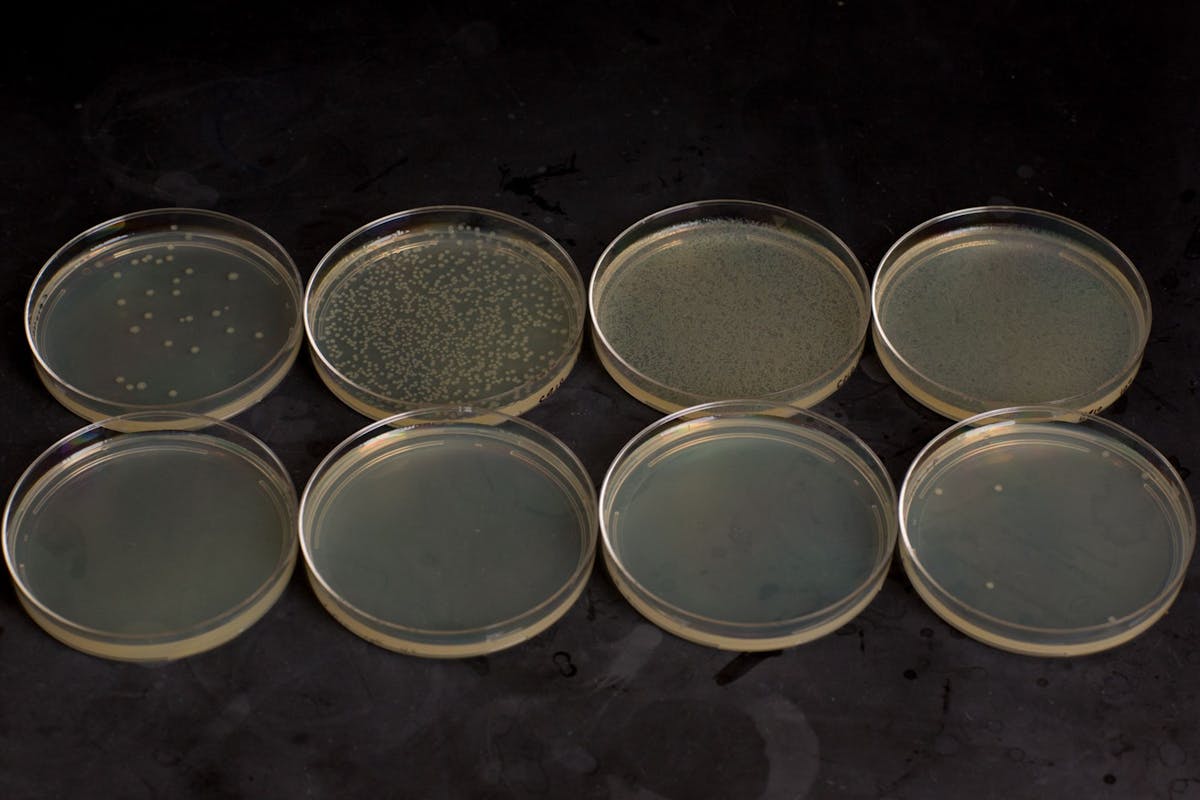Kill Switches for Engineered Microbes Gone Rogue
by Benjamin Boettner
The Author
(Originally published by the Wyss Institute for Biologically Inspired Engineering at Harvard)
November 16, 2017

Synthetic biologists are fitting the genomes of microorganisms with synthetic gene circuits to break down polluting plastics, non-invasively diagnose and treat infections in the human gut, and generate chemicals and nutrition on long-haul space flights. Although showing great promise in the laboratory, these technologies require control and safety measures that make sure the engineered microorganisms keep their functional gene circuits intact over many cell divisions, and that they are contained to the specific environments they are designed for.
Past efforts at Harvard’s Wyss Institute for Biologically Inspired Engineering led by Core Faculty members Pamela Silver and James Collins have created “kill switches” in bacteria that cause them to commit suicide in laboratory conditions when they are not wanted anymore. “We needed to take our previous work further and develop kill switches that are stable in the long run and would also be useful in real-world applications,” said Silver, who is also the Elliot T. and Onie H. Adams Professor of Biochemistry and Systems Biology at Harvard Medical School (HMS) and a member of the Kavli Institute for Bionano Science and Technology. Her research team now reports in Molecular Cell two new types of kill switches that address these challenges. The new kill switches are self-sufficient and highly stable in bacterial populations that evolve, and they last over many generations. They can ensure that only bacteria with intact synthetic gene circuits survive, or confine bacteria to a target environment at 37°C (body temperature) while inducing them to die at lower temperatures, as demonstrated during bacterial exit from a mouse intestinal tract.
For the first type of kill switch, the “Essentializer”, Silver’s team leveraged their previously engineered “memory element” that allows E. coli bacteria to remember an encounter with a specific stimulus in their environment. The memory element, derived from a bacteria-infecting virus called bacteriophage lambda, either remains silent or reports the occurrence of a signal by permanently turning on a visible reporter transgene that the scientists can trace. The signal can be any molecule, for example, an inflammatory cytokine in the gut or a toxin in the environment.
In their recent study, the team devised a way that ensures the memory element is not lost from the genome during the evolution of the bacterial population over more than a hundred generations. During that time, the genomes of individual bacteria acquire random mutations, which also could potentially occur in the memory element, destroying it in their wake. The researchers introduced the Essentializer as a separate element at another location in the bacterium’s genome. As long as the memory element remains intact, either of the two bacteriophage factors that control its function also inhibits the expression of a toxin gene encoded by the Essentializer. However, the toxin gene remains somewhat “leaky,” still producing residual amounts of toxin that can kill the cell. To keep those residual toxin levels at bay, the researchers included a second gene in their kill switch, which produces low levels of an anti-toxin that can neutralize small amounts of the toxin.
“By tying the function of the memory element to that of the Essentializer, we basically link the survival of E. coli bacteria to the presence of the memory element. The removal of the memory element from the bacterial genome, which also eliminates the two toxin-suppressing phage factors, immediately triggers the kill switch to produce high amounts of toxin that overwhelm the anti-toxin and eliminate the affected bacteria from the population,” said first author Finn Stirling, a Graduate Student working with Silver. “To create this sophisticated system of checks and balances, we also made sure that the kill switches themselves remained fully intact, which is an important prerequisite for future applications; we verified that they were still functional after about 140 cell divisions.”
The second kind of kill switch that the team calls “Cryodeath” is able to confine bacteria to a specific temperature range using the same toxin/anti-toxin combination but regulating it differently. While again, low levels of the anti-toxin were produced, the toxin gene was linked to a regulatory sequence that confers cold-sensitivity. Shifting the bacteria from 37°C, where they are supposed to thrive, to 22°C, potently induced expression of the toxin and killed the bacteria. In seminal proof-of-concept experiments, the team demonstrated the usefulness of Cryodeath in vivo. After introducing an E. coli strain containing the kill switch into mice, only 1 of 100,000 bacteria was viable in fecal samples. “This advance brings us significantly closer to real-world applications of synthetically engineered microbes in the human body or the environment. We are now working toward combinations of kill switches that can respond to different environmental stimuli to provide even tighter control,” said Silver.
“This study shows how our teams are leveraging synthetic biology not only to reprogram microbes to create living cellular devices that can carry out useful functions for medicine and environmental remediation, but to do this in a way that is safe for all,” said Wyss Institute Founding Director Donald Ingber, M.D., Ph.D., who is also the Judah Folkman Professor of Vascular Biology at HMS and the Vascular Biology Program at Boston Children’s Hospital, as well as Professor of Bioengineering at the Harvard John A. Paulson School of Engineering and Applied Sciences (SEAS).
Other authors on the study are members of Silver’s Wyss Institute and HMS team Lisa Bitzan, Samuel O’Keefe, Elizabeth Redfield; John Oliver, Ph.D., formally a Postdoctoral Fellow in Silver’s team; and Wyss Institute Senior Staff Scientist Jeffrey Way, Ph.D., who helped guide some of the experiments. The study was funded by the Wyss Institute for Biologically Inspired Engineering and the Defense Advanced Research Projects Agency.
—By Benjamin Boettner